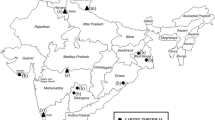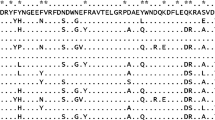Abstract
The species origin of Yunnan gayal has been controversial since many years. However, few recent genetic studies have suggested that it has perhaps originated from the hybridization between male Bos frontalis and female B. taurus or B. indicus. Being an important semi-wild bovid species, this has also been listed under the red list of International Union of Conservation of Nature and Natural Resources. However, there is limited information available about the immunogenicity of this precarious species of Bos. Major histocompatibility complex (MHC) plays a pivotal role in immune response to infectious diseases in vertebrates. In the present study, we have investigated the structural and functional characteristics and possible duplication of the MHC-DQA genes in gayal (B. frontalis). Two full-length cDNA clones of the MHC-DQA genes were amplified and designated as Bofr-DQA1 (DQA*0101) and Bofr-DQA2 (DQA*2001) with GenBank accession numbers KT318732 and KT318733, respectively. A comparison between Bofr-DQA1, Bofr-DQA2 and to other MHC-DQA molecules from different animal species showed that nucleotide and encoded amino acid sequences of these two identified MHC-DQA genes have more similarity to alleles of specific DQA1 and DQA2 molecules from other Ruminantia species than to each other. The phylogenic investigation also demonstrated a large genetic distance between these two genes than to homologous from the other species. The large genetic distance between Bofr-DQA1 and Bofr-DQA2, and the presence of different bovine DQA putative motifs clarify that these sequences are nonallelic type. These results could suggest that duplication of the DQA genes has also occurred in gayal. The findings of the present study have strengthened our understanding to MHC diversity in rare ruminants and mutation of immunological functions, selective and evolutionary forces that affect MHC variation within and between species.


Similar content being viewed by others
References
Andersson L. and Rask L. 1988 Characterization of the MHC class II region in cattle: the number of DQ genes varies between haplotypes. Immunogenetics 27, 110–120.
Ballingall K. T., Marasa B. S., Luyai A. and Mckeever G. J. 1998 Identification of diverse BoLA DQA3 genes consistent with non-allelic sequences. Anim. Genet. 29, 123–129.
Bernatchez L. and Landry C. 2003 MHC studies in non model vertebrates: what have we learned about natural selection in 15 years? J. Evol. Biol. 16, 363–377.
Brown J. H., Jardetzky T. S., Gorge J. C., Stern L. J., Urban R. G., Strominger J. L. et al. 1993 Three dimensional structure of the human class II histocompatibility antigen HLA-DR1. Nature 364, 33–39.
Chi J., Fu B., Nie W., Wang J., Graphodatsky A. S. and Yang F. 2005 New insights into the karyotypic relationships of Chinese muntjac (Muntiacus reevesi), forest muskdeer (Moschus berezovskii) and gayal (Bos frontalis). Cytogenet. Genome Res. 108, 310–316.
Germain R. N. 1995 The biochemistry and cell biology of antigen presentation by MHC class I and class II molecules. Implications for development of combination vaccines. Ann. N. Y. Acad. Sci. 754, 114–125.
Glass E. J., Oliver R. A. and Russell G. C. 2009 Duplicated DQ haplotypes increases the complexity of restriction element usage in cattle. J. Immunol. 165, 134–138.
Gou X., Wang Y. Q., Yang S. L., Deng W. D. and Mao H. M. 2010 Genetic diversity and origin of gayal and cattle in Yunnan revealed by mtDNA D-loop and SRY gene sequence variation. J. Anim. Breed. Genet. 127, 154–160.
He Y., Xi D., Leng J., Qian T., Jin D., Chen T. et al. 2014 Genetic variability of MHC class II DQB exon 2 alleles in yak (Bos grunniens). Mol. Biol. Rep. 41, 2199–2206.
Kappes D. and Strominger J. L. 1988 Human class II major histocompatibility complex genes and proteins. Annu. Rev. Biochem. 57, 991–1028.
Klein J. 1986 Seeds of time: fifty years ago Peter A. Gorer discovered the H-2 complex. Immunogenetics 24, 331–338.
Kuduk K., Babik W., Bojarska K., Sliwinska E. B., Kingberg J., Taberlet P. et al. 2012 Evolution of major histocompatibility complex class I and class II genes in the brown bear. BMC Evol. Biol. 12, 197.
Lan H., Xiong X., Lin S., Liu A. and Shi L. 1993 Mitochondrial DNA polymorphism of cattle (*Bos taurus*) and mithun (*Bos **frontalis*) in Yunnan Province. Acta Gen. Sin. 20, 419–425.
Lazzaro B. P. and Little T. J. 2009 Immunity in a variable world. Philos. Trans. R. Soc. London, Ser. B 364, 15–26.
McKinney D. M., Southwood S., Hinz D., Osseroff C., Arlehamn C. S., Schulten V. et al. 2013 Strategy to determine HLA class II restriction broadly covering the DR, DP, and DQ allelic variants most commonly expressed in the general population. Immunogenetics 65, 357–370.
Nie L., Shi L., He X. D., Zhao Y. L., Mu W. G. and Zhang J. L. 1995 The gayal’s genetic diversity and its genetic structure’s enzyme analysis. Acta. Genet. Sin. 22, 185–191.
Niranjan S. K., Deb S. M., Sharma A. and Kumar S. 2009 Isolation of two cDNAs encoding MHC-DQA1 and -DQA2 from the water buffalo, Bubalus bubalis. Vet. Immunol. Immunopathol. 130, 268–271.
Perera B. M. 2011 Reproductive cycles of buffalo. Anim. Reprod. Sci. 124, 194–199.
Rajkhowa S., Rajkhowa C., Rahman H. and Bujarbaruah K. M. 2004 Seroprevalence of infectious bovine rhinotracheitis in mithun (Bos frontalis) in India. Rev. Sci. Tech. 23, 821–829.
Reed D. H. and Frankham R. 2003 Correlation between fitness and genetic diversity. Conserv. Biol. 17, 230–237.
Rudd P. M., Wormald M. R., Stanfield R. L., Huang M., Mattsson N., Speir J. A. et al. 1999 Roles for glycosylation of cell surface receptors involved in cellular immune recognition. J. Mol. Biol. 293, 351–366.
Russell B. C., Gallagher A., Craigmile S. and Glass E. J. 1997 Characterization of cattle cDNA sequences from two DQA loci. Immunogenetics 45, 455–458.
Sena L., Schneider M. P., Brenig B. B., Honeycutt R. L., Honeycutt D. A., Womack J. E. et al. 2011 Polymorphism and gene organization of water buffalo MHC-DQBgenes show homology to the BoLA DQB region. Anim. Genet. 42, 378–385.
Sigurdardottir S., Borsch C., Gustafsson K. and Andersson L. 1992 Gene duplications and sequence polymorphism of bovine class II DQB genes. Immunogenetics 35, 205–213.
Simoons F. J. 1984 Gayal or mithan. In Evolution of domesticated animals (ed. I. L. Mason), pp. 34–38. Longman, London.
Sun Y., Xi D., Li G., Hao T., Chen Y. and Yang Y. 2014 Genetic characterization of MHC class II DQB exon 2 variants in gayal (Bos frontalis). Biotechnol. Biotec. Eq. 28, 827–833.
Tamura K., Dudley J., Nei M. and Kumar S. 2007 MEGA4: molecular evolutionary genetics analysis (MEGA) software version 4.0. Mol. Biol. Evol. 24, 1596–1599.
Tibayrenc M. 2004 A molecular biology approach to tuberculosis. Proc. Natl. Acad. Sci. USA 101, 4721–4722.
Trowsdale J. 2001 Genetic and functional relationships between MHC and NK receptor genes. Immunity 15, 363–374.
Trowsdale J. and Parham P. 2004 Defense strategies and immunity-related genes. Eur. J. Immunol. 34, 7–17.
Verkaar E. L. C., Nijman I. J., Beeke M., Hanekamp E. and Lenstra J. A. 2004 Maternal and paternal lineages in cross-breeding bovine species. Has Wisent a hybrid origin? Mol. Biol. Evol. 21, 1165–1170.
Walker E., Warnick F. and Hamlet S. 1968 Mammals of the world. The Johns Hopkins Press, Balttmore.
Williams A., Peh C. A. and Elliott T. 2002 The cell biology of MHC class I antigen presentation. Tissue Antigens 59, 3–17.
Xi D. M., Wanapat M., Deng W. D., He T. B., Yang Z. F. and Mao H. M. 2007 Comparison of gayal (Bos frontalis) and Yunnan Yellow Cattle (Bos taurus): in vitro dry matter digestibility and gas production for a range of forages. Asian-Aust. J. Anim. Sci. 20, 1208–1214.
Yang Z. 2007 PAML 4: Phylogenetic analysis by maximum likelihood. Mol. Biol. Evol. 24, 1586–1591.
Zhao K. D., Ou C. H., Huang Y. L. and He T. B. 2003 Rare animal germplasm resources in Yunnan Province: present situation and counter measures of preservation and research on Dulong cattle (Bos frontalis). J. Yellow Cattle Sci. 29, 71–74 (in Chinese with English abstract).
Acknowledgements
Authors acknowledge the support and cooperation received from the Dean, Faculty of Animal Science and Technology, Yunnan Agricultural University, China. We also thank the villagers and locals who helped us in sampling the gayal and the colleagues for synchronizing their work and help in wet lab experiments. Funding was provided by the National Nature Science Foundation of China under project nos. 31460583 and 31101640. Partial funding was also provided by the Yunnan Provincial Key Laboratory of Animal Nutrition and Feed with grant no. DYCX2015004.
Author information
Authors and Affiliations
Corresponding author
Additional information
Corresponding editor: Indrajith Nanda
Electronic supplementary material
Below is the link to the electronic supplementary material.
Rights and permissions
About this article
Cite this article
Memon, S., Wang, L., Li, G. et al. Isolation and characterization of the major histocompatibility complex DQA1 and DQA2 genes in gayal (Bos frontalis). J Genet 97, 121–126 (2018). https://doi.org/10.1007/s12041-018-0882-3
Received:
Revised:
Accepted:
Published:
Issue Date:
DOI: https://doi.org/10.1007/s12041-018-0882-3




